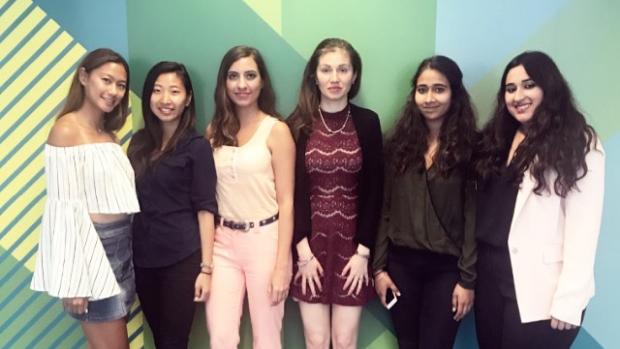Want to Start a Tech Business? With I-Corps, You Can

Members of the first group of participants in NYU’s I-Corps Site Summer Program
Back in July, when Chandrika Tandon, Chair of the Tandon School of Engineering’s Board of Overseers and Vice Chair of the NYU Board of Trustees, told the first group of participants in NYU’s I-Corps Site Summer Program, “NYU is committed to the success of each and every one of you,” she may not have realized just how rapidly those successes would begin to accrue.
Funded by an NSF I-Corps Site grant for “Enhancing Diversity in STEM Entrepreneurship,” the program, overseen by Associate Professor of Chemical and Biomolecular Engineering Jin Kim Montclare, who also directs the school’s Convergence of Innovation and Entrepreneurship (CIE) Institute, introduced the aspiring tech entrepreneurs (many of them women or those from other groups underrepresented in STEM) to Lean Launchpad methodology and encouraged them to develop marketable solutions to real-world problems.
The top teams — who won monetary awards with which to further refine and prototype their ideas — tackled a variety of challenges in cost-efficient, effective, and out-of-the-box ways.
One team, led by master’s candidate Xuan Xie, addressed an issue all too familiar to high school chemistry students: the difficulty of following along as a teacher outlines a complicated experiment. Their solution is LabLessons.com, a comprehensive online interactive learning platform. The platform integrates a series of useful study resources — including e-textbooks, quizzes and reviews — and builds a bridge between theoretical and practical study by providing visualizations and simulations of concepts and experiments. Additionally, it allows teachers to modify their labs, track student performance, and communicate with parents and students conveniently. “During the customer discovery phase of the program, we interviewed more than 70 teachers and students,” Xie recalled, “so we found out where all of the pain points are.”
Andrew Olsen, a student in Montclare’s lab, led a team that explored pain points of a different sort. He and teammate Priya Katyal are engineering a way to break down toxic pesticides in an environmentally friendly way using enzymes — a solution that they predict will appeal to farmers seeking to manage their soil or firms engaged in bioremediation. “We learned a lot during the customer discovery process,” Olsen said, “and we’re excited for the next step, which is testing out in the field — in our case, that would be field in the literal sense.”
The wide range of products and services our participants created is a testament to the importance of having different voices and points of view at the table.”
— Associate Professor Jin Kim Montclare
Deniz Vurmaz, a doctoral candidate in the Department of Chemical and Biomolecular Engineering, is a veteran of entrepreneurial competitions, having already won an NYU Green Grant and an award from the American Association of Black Engineers for her team idea: an automated, data-driven machine called APGthat employs a biochemical method of turning food scraps into energy and other marketable products. Vurmaz believes that APG will be of great interest to restaurants, schools, and even private homes one day, and to that end, she has launched a company, Lostbytes, to design and tailor artificial intelligence solutions aimed at saving money, reducing waste, and producing clean energy. “With New York City aiming to have zero food waste by 2030, the time is exactly right for us to contribute to that cause,” she says.
Spencer Cappiello, a senior who hails from the West Coast, is also on a mission: to make virtual reality systems more affordable and accessible. “Right now, the physical equipment needed to create a VR experience can cost thousands of dollars, and there are artists and programmers who can’t realize their vision because of the expense involved,” he says. “I’d like to see high-quality equipment made as easy to afford as a smartphone.” To that end he is developing a platform-agnostic, open-source tracking system that he projects will be an eighth of the price of existing models. “During a VR experience, the system must track a user’s motions in space; think of it as something like a 3D mouse,” he explains. “Thanks to I-Corps, I’m getting ready to get kits out to developers, and it will be very exciting to see what innovative applications they come up with.”
Carlos Valle-Diaz, a computer science and engineering major, led a team that also focused on the needs of media users. “Almost all of us can relate to the problems that come with ear buds,” he says. “They die too quickly or we’re careless and forget to charge them.” Their solution is a set of wireless buds that will charge as they are being used — an idea that they found to have near-universal appeal in their customer-discovery phase. “The summer program’s focus was on having collaborative and diverse teams,” he says, “and that really served us well in coming up with a good solution to a problem many, many of us have.”
Montclare affirms that the program proved to be a showcase for the role inclusion and diversity can play in innovation. “The wide range of products and services our participants created is a testament to the importance of having different voices and points of view at the table,” she asserts. “I know our second cohort of students will be just as creative, practical, and inventive.”





